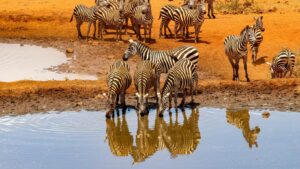When people think of Africa, they often imagine a sun-drenched landscape, sweltering heat, and vast deserts. But does it ever get cold in Africa? It’s a question that’s been asked time and again, and one that deserves a closer look.
This article aims to debunk the myth of a perpetually hot Africa and shed light on Africa’s diverse climatic conditions.
Does It Get Cold In Africa
It’s a common belief, but not entirely accurate, that Africa experiences relentless heat all year round. There are instances that flout this perception, such as the sudden drop in temperatures during the nighttime in the vast Sahara Desert or the perpetual snow at the summit of Mount Kilimanjaro.
Consider Algeria, for instance, the largest African nation. It’s home to both extraordinarily hot summers and icy-cold winters, offering a stark example of the continent’s climatic diversity. In Saharan towns like Tamanrasset, temperatures can plunge below zero during winter nights. This contradicts the stereotype of Africa’s uniform heat.
Climate Zones in Africa

The variance in climate stems from the vastness of Africa, encompassing six climatic zones that categorically disprove the myth of constant heat. Each zone’s distinct weather patterns attest to the continent’s sizable meteorological range, confounding the typical portrayal of Africa as persistently hot.
The Equatorial region, for instance, characterized by high humidity and constant rainfall, contrasts sharply with the arid Sahara’s low rainfall and extreme heat. At the same time, the Temperate Mediterranean zone enjoys mild, wet winters and hot, dry summers, unlike the more moderate conditions of the Humid Subtropical region. The Cold Desert and Mountain zones complete the picture, with low temperatures that can drop to freezing, reinforcing Africa’s climatic diversity to be more than just heat.
Regions Where It Gets Cold in Africa
With the previous commentary debunking the incessant heat stereotype about Africa, they explore regions that experience cold conditions.
The Mountains and Highlands

A notable region with cold climates in Africa consists of the mountains and highlands. The Transverse Mountain ranges of Morocco, where snowfall is a regular occurrence in winter months, stand as cases-in-point. Similarly, the Drakensberg Mountains, stretching through Lesotho, Swaziland, and part of South Africa, experience freezing temperatures, often dropping below 0°C (32°F) in winter. Equally chilly are the Ethiopian Highlands, often touted as “the roof of Africa,” where temperatures regularly fall to 10°C (50°F) and below.
The surprise yet outstanding example lies in Tanzania with Mount Kilimanjaro. It’s not only Africa’s tallest peak but also home to one of the few permanent snowfields in Africa. Backpackers and mountaineers ascending Kilimanjaro wear heavy winter gear to protect themselves against the bone-chilling cold, a testament to the reality of cold conditions in African mountains.
The Southernmost Countries
The southern cone of Africa, composed primarily of South Africa, Lesotho, and Swaziland, sees considerable seasonal temperature changes. These southernmost countries present proof that Africa isn’t all about heat. Their winter months, from May to September, often witness temperatures dropping significantly, occasionally falling to freezing points.
Centuries-old colonial architecture in the South African cities of Johannesburg and Pretoria bear signs of frozen precipitation—ice and sometimes snow—while Lesotho’s winter landscape transforms into snow-capped peaks, perfect for winter sports.
Indeed, these southern regions reaffirm the temperature diversity in Africa and bust the myth of eternal African heat, further emphasizing the continent’s broad meteorological range.
Conclusion

Africa’s climate isn’t just about scorching heat. It’s a continent of varied weather patterns, from snow-capped peaks to chilly desert nights.
The six climatic zones offer a diverse range of weather, debunking the common misconception of Africa as perpetually hot. Regions like the Transverse Mountain ranges of Morocco, the Drakensberg Mountains, and the Ethiopian Highlands experience cold conditions.
Even southernmost countries such as South Africa, Lesotho, and Swaziland undergo significant seasonal temperature changes.
So, it’s clear that Africa, much like any other continent, has its fair share of cold weather. This broad meteoro logical range makes Africa a continent of climatic surprises, far from the stereotype of always being hot.
